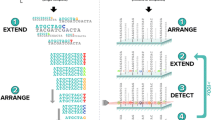Abstract
In this study, we assessed 30 insertion–deletion polymorphisms (Indels) (Investigator DIPplex® kit) in four Chinese populations (n = 952) and evaluated their usefulness in forensic genetic applications. After the Bonferroni correction at a 95 % significance level (p = 0.0017), there were no deviations from the Hardy–Weinberg equilibrium observed except for the HLD114 locus in the Tibetan ethnic group studied. A high level of discrimination power was observed for the DIPplex® kit in four sample populations (CDP > 0.9999) and the combined random match probabilities (CMP) were in the range of 1.4766 × 10−11 to 5.2742 × 10−13. Four Indels have been selected for further analyses as possible ancestry informative single nucleotide polymorphisms. The study support that the Investigator DIPplex® kit provides a powerful supplement to standard short tandem repeat-based kits for individual identification and kinship analysis in the Chinese population.

Similar content being viewed by others
Change history
26 February 2020
‘Concerns have been raised about the ethics approval and informed consent procedures related to the research reported in this paper. The paper includes the following author declarations: “All participants following informed consent were chosen among individuals whose ancestors had lived in the region for at least three generations. This study was conducted in accordance with the human and ethical research principles of Shantou University, Shantou, Guangdong, People’s Republic of China.”. Editorial action will be taken as appropriate once an investigation of the concerns is complete and all parties have been given an opportunity to respond in full.’
References
Pereira R, Phillips C, Alves C, Amorim A, Carracedo A, Gusmaõ L (2009) Insertion/deletion polymorphisms: a multiplex assay and forensic applications. Forensic Sci Int Genet Suppl Ser 2:513–515
Wei YL, Qin CJ, Dong H, Jia J, Li CX (2014) A validation study of a multiplex INDEL assay for forensic use in four Chinese populations. Forensic Sci Int Genet 9:e22–e25
Kim EH, Lee HY, Yang IS, Yang WI, Shin KJ (2014) Population data for 30 insertion-deletion markers in a Korean population. Int J Legal Med 128:51–52
Carvalho A, Pinheiro MF (2013) Population data of 30 insertion/deletion polymorphisms from a sample taken in the North of Portugal. Int J Legal Med 127:65–67
Friis SL, Børsting C, Rockenbauer E, Poulsen L, Fredslund SF, Tomas C, Morling N (2012) Typing of 30 insertion/deletions in Danes using the first commercial Indel kit—Mentype® DIPplex. Forensic Sci Int Genet 6:e72–e74
Zidkova A, Horinek A, Kebrdlova V, Korabecna M (2013) Application of the new insertion–deletion polymorphism kit for forensic identification and parentage testing on the Czech population. Int J Legal Med 127:7–10
Martín P, García O, Heinrichs B, Yurrebaso I, Aguirre A, Alonso A (2013) Population genetic data of 30 autosomal Indels in Central Spain and the Basque Country populations. Forensic Sci Int Genet 7:e27–e30
LaRue BL, Ge JY, King JL, Budowle B (2012) A validation study of the Qiagen Investigator DIPplex® kit; an INDEL-based assay for human identification. Int J Legal Med 126:533–540
Walsh BS, Petzger DA, Higuchi R (1991) Chelex-100 as medium for simple extraction of DNA for PCR-based typing from forensic material. Biotechniques 10:506–513
Weir B, Cockerham CC (1984) Estimating F-statistics for the analysis of population structure. Evolution 38(6):1358–1370
Kidd JR, Friedlaender FR, Speed WC, Pakstis AJ, De La Vega FM, Kidd KK (2011) Analyses of a set of 128 ancestry informative single-nucleotide polymorphisms in a global set of 119 population samples. Invest Genet 2:1
Phillips C, Salas A, Sanchez JJ, Fondevila M, Gomez-Tato A, Alvarez-Dios J, Calaza M, de Cal MC, Ballard D, Lareu MV, Carracedo A (2007) SNPforID Consortium, Inferring ancestral origin using a single multiplex assay of ancestry-informative marker SNPs. Forensic Sci Int Genet 1:273–280
Yao YG, Kong QP, Wang CY, Zhu CL, Zhang YP (2004) Different matrilineal contributions to genetic structure of ethnic groups in the Silk Road Region in China. Mol Biol Evol 2004(21):2265–2280
Xu S, Huang W, Qian J, Jin L (2008) Analysis of genomic admixture in Uyghur and its implication in mapping strategy. Am J Hum Genet 82:883–894
Xu S, Jin W, Jin L (2009) Haplotype-sharing analysis showing Uyghurs are unlikely genetic donors. Mol Biol Evol 26:2197–2206
Poetsch M, Bajanowski T, Pfeiffer H (2012) The publication of population genetic data in the International Journal of Legal Medicine guidelines. Int J Legal Med 126:489–490
Acknowledgments
We thank all sample donors for their contributions to this work and all those who helped with sample collection. This study was supported by The National Natural Science Foundation of China (NSFC. No. 81172902), the Program for New Century Excellent Talents in University (No. NCET-10-0773), the China Postdoctoral Science Foundation funded project (No.2013M530371), and the Li Ka Shing Foundation, Hong Kong.
Author information
Authors and Affiliations
Corresponding author
Electronic supplementary material
Below is the link to the electronic supplementary material.
Supplementary Fig S1
(DOCX 62 kb)
Supplementary Table 1
(XLSX 263 kb)
Supplementary Table 2
(XLS 58 kb)
Supplementary Table 3
(XLSX 17 kb)
Rights and permissions
About this article
Cite this article
Shi, M., Liu, Y., Bai, R. et al. Population data of 30 insertion–deletion markers in four Chinese populations. Int J Legal Med 129, 53–56 (2015). https://doi.org/10.1007/s00414-014-1091-0
Received:
Accepted:
Published:
Issue Date:
DOI: https://doi.org/10.1007/s00414-014-1091-0




